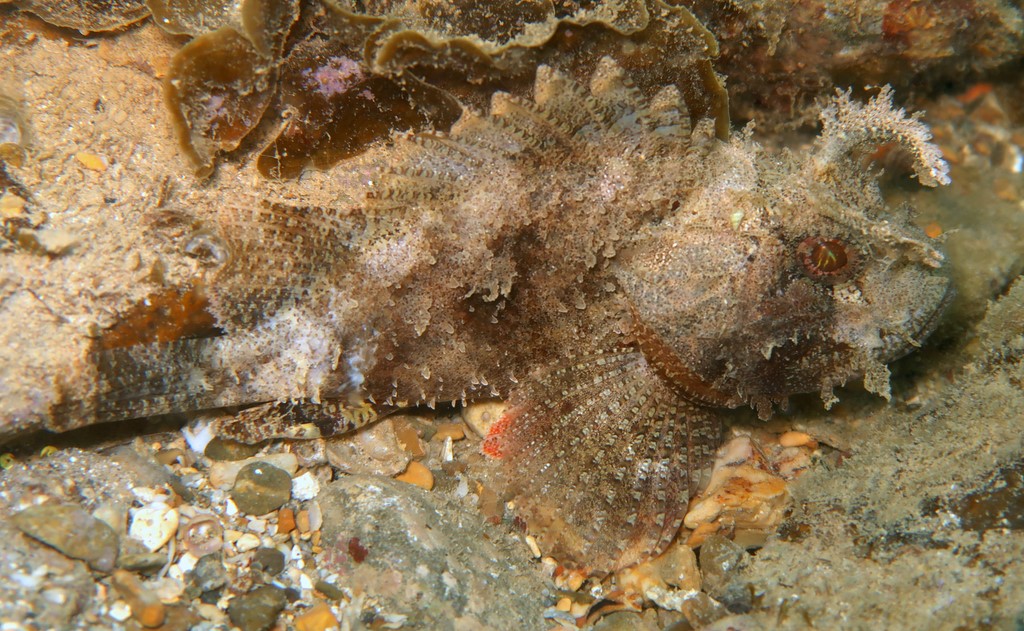PARASCORPAENA MOSSAMBICA - (PETERS, 1855)
Picture courtesy of: Alain Daoulas
Actinopterygii (Gigaclass) > Actinopteri (Class) > Teleostei (Subclass) > Perciformes (Order) > Scorpaenoidei (Suborder) > Scorpaenidae (Family) > Scorpaeninae (Subfamily) > Parascorpaena (Genus)
Poisson-scorpion du Mozambique, Golden scorpionfish, Mozambique scorpionfish, Goue skerpioenvis, Nettaifusakasago, ネッタイフサカサゴ, 莫桑比克圓鱗鮋, 石狗公, 莫三鼻克圓鱗鮋,
Synonyme
Scorpaena mossambica (Peters, 1855)
-----------------------
Description
Dorsal spines (total): 12; Dorsal soft rays (total): 9½; Anal spines: 3; Anal soft rays: 5½; Pectoral fin rays: 15-17; Caudal fin rays: 13. Suborbital ridge with 3 spines (1 spine on ventral ridge of 2nd suborbital (with 2 slightly curved ridges), and 2 spines on 3rd suborbital). Supraocular cirrus usually long, often longer than orbit diameter. Occiput of shallow or moderate depth. Teeth near lower jaw symphysis all villiform, none enlarged. Lachrymal with 2 spines on ventral margin, posteriormost retrorse, its point curved forward (except in small juveniles); Scales on body primarily pseudocycloid (rarely with weak ctenii). Vertebrae: 9 + 15 = 24. Gill rakers: 3-5/1/6-10 = 11-16. Lateral line scales: 23-24; Lateral scale series: 36-42. Pyloric caeca: 5. Max. length: 12.0 cm TL. Depth range: 0 - 18 m.
Color
Body color variably red, orangish, reddish brown or brown; Often with scattered (sometimes black) blotches and spots on head and body, and white mottling especially ventrally.
Etymology
Parascorpaena: from Greek, para = near, in the side + from Latin, scorpaena = a kind of fish. Described as similar to Scorpaena but distinguished by the presence of an anteroventrally directed posterior lacrimal spine.
mossambica: type locality of the discover, Mozambique.
Original description: Scorpaena mossambica Peters, 1855 - Type locality: Ibo, 12°S, Mozambique, western Indian Ocean.
Distribution
Red Sea; Indian Ocean: KwaZulu-Natal (South Africa), East Africa, Seychelles, Comoros, Madagascar and western Mascarenes (La Réunion, Mauritius), east to western Indonesia, Australia and New Caledonia.
Biology
Inhabits areas with mixed sand and rubble in reef flats, shallow lagoons, and channels. Hides during the day, ventures out in the open at night. Anterolateral glandular groove with venom gland. Solitary.
Similar species
Parascorpaena armata (Sauvage, 1873) - Reported from Western Pacific. Specimens from the Pacific Ocean, currently regarded as Parascorpaena mossambica, are most likely to be Parascorpaena armata (H. Motomura, unpublished data-2011).
Last update: 26, July 2024
